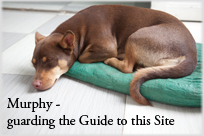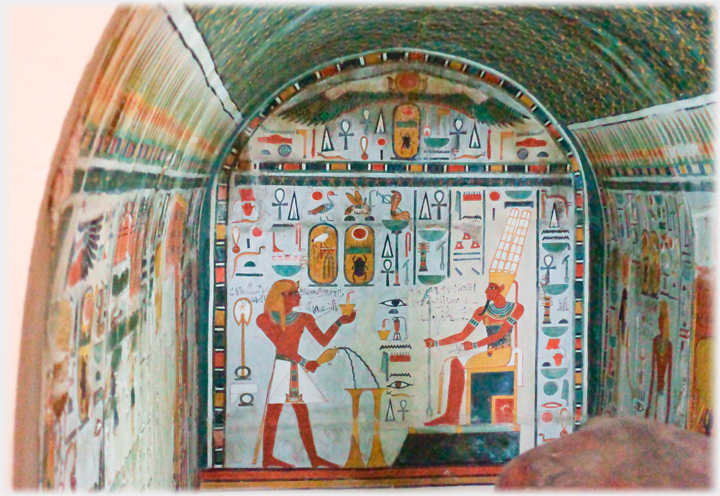 This sandstone chapel, reassembled in the Museum, is immaculately preserved. It dates from the Eighteenth Dynasty. There is
a dynasty list below
This sandstone chapel, reassembled in the Museum, is immaculately preserved. It dates from the Eighteenth Dynasty. There is
a dynasty list below
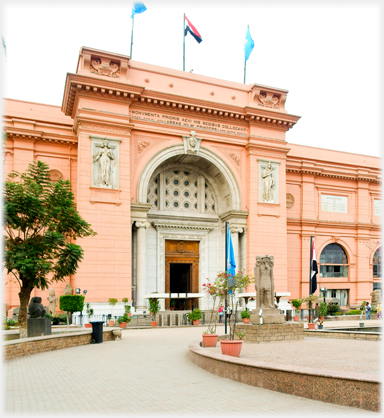 Main entrance of the 1900 building. A new futuristic building is under construction on the western edge of Cairo within direct view of the Giza pyramids
On the east side of the Nile, by Tahrir Square, sits the Egypt Museum - more formally the
Egyptian Antiquities Museum.
Its basic collection opened in 1858 with the help of French archaeologists and these objects moved to the present building in 1900. Most of the displays relate to the pharaonic period from the First Dynasty starting in 3,100 BC, to the Thirty-first ending in 332 BC, and with the following Ptolemy Dynasty which finished in 30 BC, plus a little from the Roman era. There are some 107 galleries, displaying a selection of objects from the 160,000 item collection.
Many items shown are in glass cases, please forgive the distortions and reflections letting these remind you that you are seeing objects in a museum.
Main entrance of the 1900 building. A new futuristic building is under construction on the western edge of Cairo within direct view of the Giza pyramids
On the east side of the Nile, by Tahrir Square, sits the Egypt Museum - more formally the
Egyptian Antiquities Museum.
Its basic collection opened in 1858 with the help of French archaeologists and these objects moved to the present building in 1900. Most of the displays relate to the pharaonic period from the First Dynasty starting in 3,100 BC, to the Thirty-first ending in 332 BC, and with the following Ptolemy Dynasty which finished in 30 BC, plus a little from the Roman era. There are some 107 galleries, displaying a selection of objects from the 160,000 item collection.
Many items shown are in glass cases, please forgive the distortions and reflections letting these remind you that you are seeing objects in a museum.
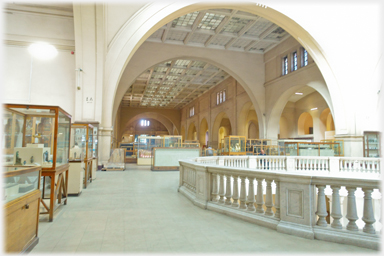 Upper floor of museum. Galleries run off to right and left
Upper floor of museum. Galleries run off to right and left
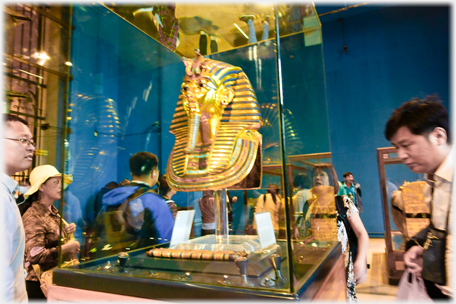 Visitors (a majority from the Far East) and the famous Tutankhamun mask which modelled exactly his facial features
Visitors (a majority from the Far East) and the famous Tutankhamun mask which modelled exactly his facial features
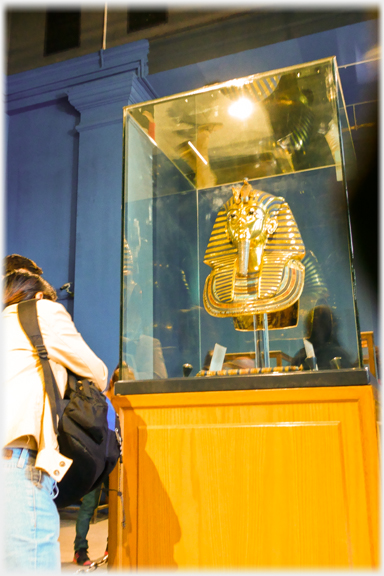 Security personnel hover to prevent photography in the Tutankhamun Room, so shots have to be discreet
The number of exhibits on display is vast and needs weeks of attention. In addition there is the possibility of visiting the mummies and special exhibitions. The materials found in the Tutankhamun grave form a centre point of the general collection.
Security personnel hover to prevent photography in the Tutankhamun Room, so shots have to be discreet
The number of exhibits on display is vast and needs weeks of attention. In addition there is the possibility of visiting the mummies and special exhibitions. The materials found in the Tutankhamun grave form a centre point of the general collection.
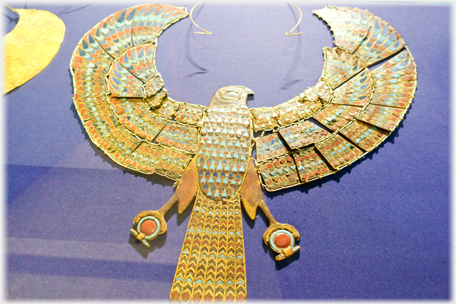 Above and below are two items of the Tutankhamun regalia showing the astonishingly beautiful jewellery that was being created in the Eighteenth Dynasty
Above and below are two items of the Tutankhamun regalia showing the astonishingly beautiful jewellery that was being created in the Eighteenth Dynasty
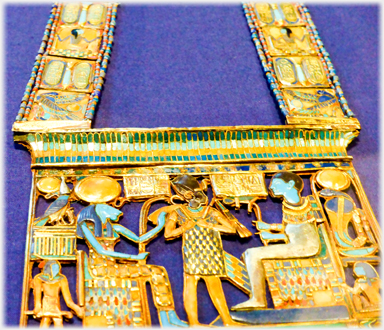 Egyptian Dynasties
Egyptian Dynasties
For a full list of the Egyptian Dynasties go to a Wikipedia article. The following are the approximate dates of dynasties referred to on this page:
Old Kingdom
Fourth Dynasty - 2600 to 2500 BC
Sixth Dynasty - 2350 to 2200 BC Middle Kingdom
Eleventh Dynasty - 2150 to 2000 BC Twelfth Dynasty - 2000 to 1800 BC
Second Intermediate Period
Seventeenth Dynasty - 1580 to 1550 BC
New Kingdom
Eighteenth Dynasty - 1550 to 1300 BC
Nineteenth Dynasty - 1300 to 1200 BC
Twentieth Dynasty - 1200 to 1050 BC
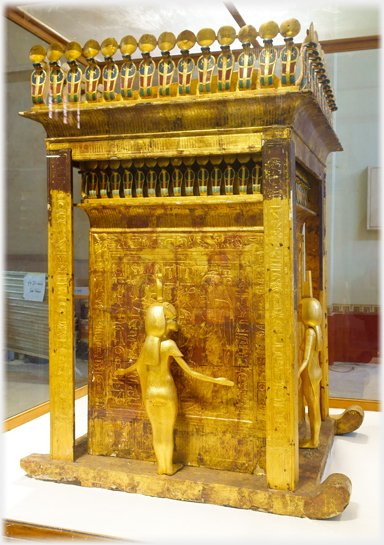 The gold Canopic Shrine of Tutankhamun is so named as it holds the canopic urn (entrails container) associated with his mummification
The gold Canopic Shrine of Tutankhamun is so named as it holds the canopic urn (entrails container) associated with his mummification
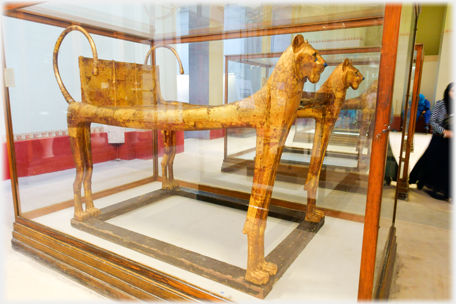 One of the ritual beds used to hold the body during the mummification process
One of the ritual beds used to hold the body during the mummification process
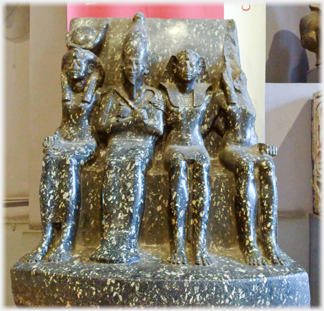 King Horemheb, of the Eighteenth Dynasty, had been the chief advisor to Tutankhamun before becoming king himself, here he is depicted sitting as an equal with (probably) the gods Isis, Horus and Osiris
It is a most marvellous museum, gently jumbled, a touch uninformative, but crammed with items of the greatest beauty linked to an utterly absorbing history.
King Horemheb, of the Eighteenth Dynasty, had been the chief advisor to Tutankhamun before becoming king himself, here he is depicted sitting as an equal with (probably) the gods Isis, Horus and Osiris
It is a most marvellous museum, gently jumbled, a touch uninformative, but crammed with items of the greatest beauty linked to an utterly absorbing history.
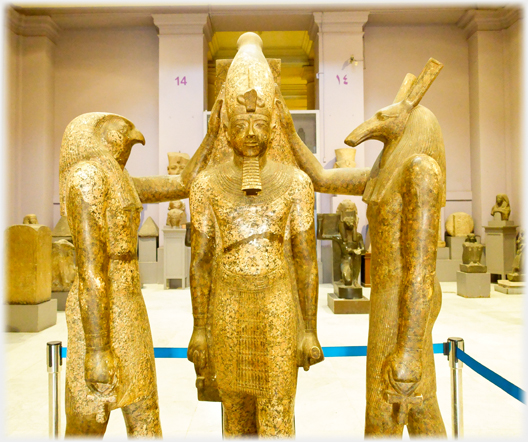 In this group Ramses III, of the Twentieth Dynasty, is shown with the gods Horus (falcon's head) and Seth performing his coronation. The love of animal incarnations of the gods is shown again in the image to the right, this is the god Anubis who often appeared in canine or jackal form. Here he is sitting on a shrine shaped box waiting to do his work of conductor of the deceased to the underworld
In this group Ramses III, of the Twentieth Dynasty, is shown with the gods Horus (falcon's head) and Seth performing his coronation. The love of animal incarnations of the gods is shown again in the image to the right, this is the god Anubis who often appeared in canine or jackal form. Here he is sitting on a shrine shaped box waiting to do his work of conductor of the deceased to the underworld
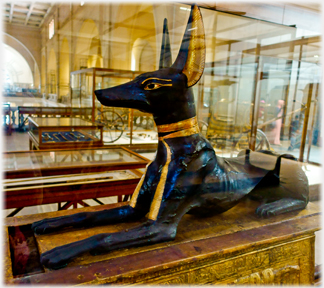
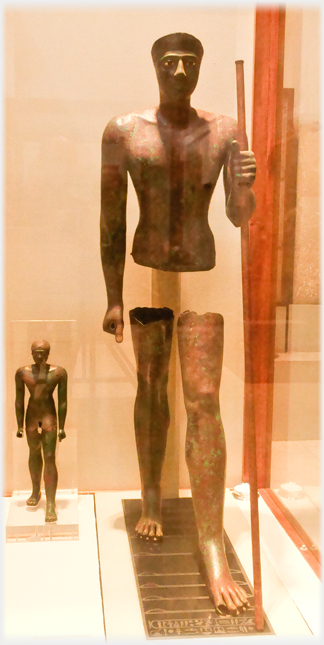 Pepi I of the Sixth Dynasty is embodied in this hollow copper statue. The loins and the rear of the head are missing indicating that a different material was used for them. Behind is a representation either of his son or himself as a younger man. Underfoot he tramples the bows of the nine enemies of Egypt
Pepi I of the Sixth Dynasty is embodied in this hollow copper statue. The loins and the rear of the head are missing indicating that a different material was used for them. Behind is a representation either of his son or himself as a younger man. Underfoot he tramples the bows of the nine enemies of Egypt
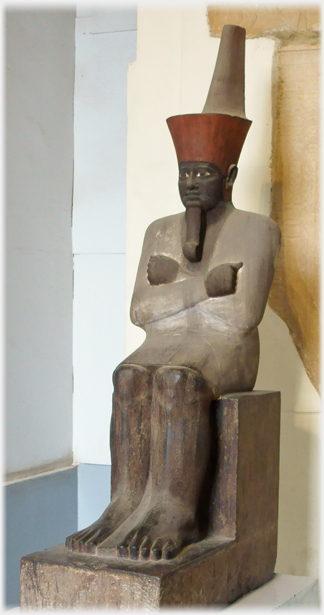 Nebhepetre Mentuhotep II was the sixth pharaoh of the Eleventh Dynasty. Under his rule, after a period of division, Egypt was again united and so formed the start of what is known as the Middle Kingdom. His reign was long and may have lasted as much as 51 years. The longest documented reign was of Ramses II which was 67 years - most reigns were short!
Nebhepetre Mentuhotep II was the sixth pharaoh of the Eleventh Dynasty. Under his rule, after a period of division, Egypt was again united and so formed the start of what is known as the Middle Kingdom. His reign was long and may have lasted as much as 51 years. The longest documented reign was of Ramses II which was 67 years - most reigns were short!
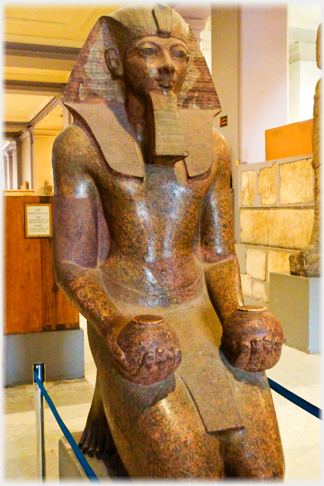 Queen Hatshepsut shown above as a man holding two offering vases...
Queen Hatshepsut shown above as a man holding two offering vases...
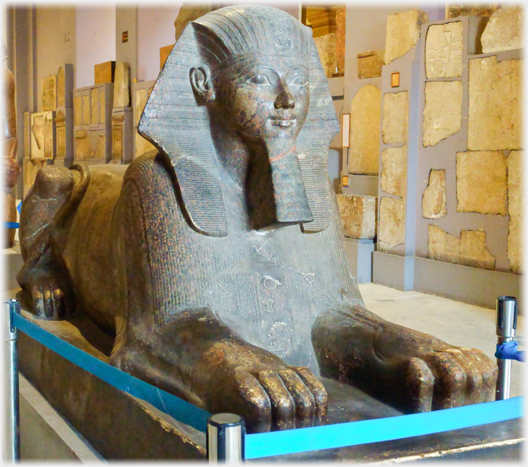 ...and here she is shown as a sphinx with delicate female features. She is the second fully documented female pharaoh, and her reign was marked by success in trade and public works
...and here she is shown as a sphinx with delicate female features. She is the second fully documented female pharaoh, and her reign was marked by success in trade and public works
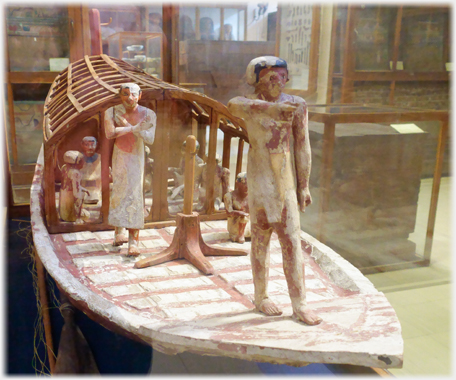 These Eleventh Dynasty models were included in grave goods, the one above shows prince Mesheti on a picnic on the Nile...
These Eleventh Dynasty models were included in grave goods, the one above shows prince Mesheti on a picnic on the Nile...
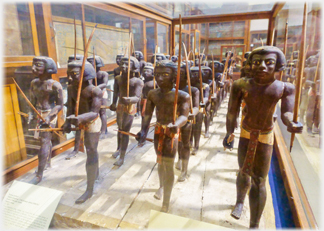 ...and these two models each have a group of 40 marching armed men, the ones above are archers from Nubia carrying bows and arrows, and the the ones below are pikes-men
...and these two models each have a group of 40 marching armed men, the ones above are archers from Nubia carrying bows and arrows, and the the ones below are pikes-men
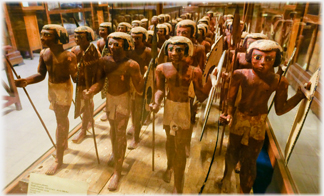
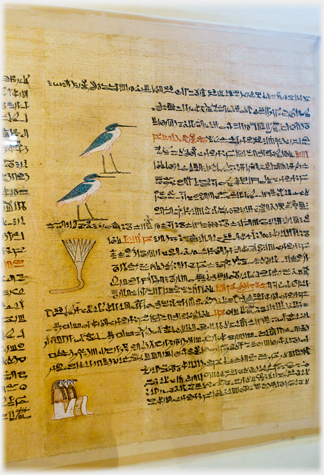
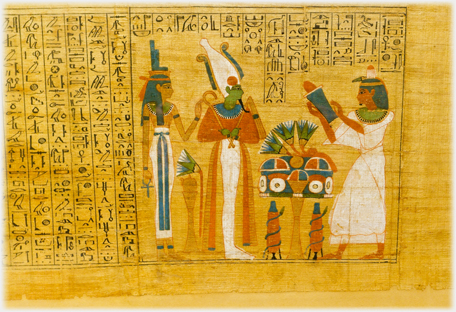 Two of the galleries have a wide range of examples of calligraphy with Egyptian hieroglyphics and later alphabets. Many of these papyri have beautiful coloured images of birds, animals and people
Two of the galleries have a wide range of examples of calligraphy with Egyptian hieroglyphics and later alphabets. Many of these papyri have beautiful coloured images of birds, animals and people
View an enlarged image
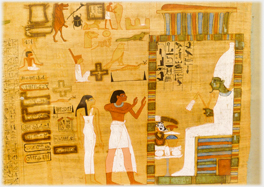 Hieroglyphics made for slow writing, so in time Hieratic writing developed...
Hieroglyphics made for slow writing, so in time Hieratic writing developed...
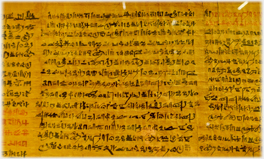 ...as in the above example which is from instructions for the dead, or as we know it 'The Egyptian Book of the Dead'...
...as in the above example which is from instructions for the dead, or as we know it 'The Egyptian Book of the Dead'...
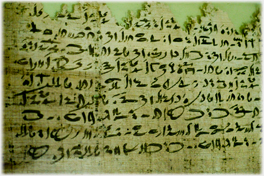 ...and in turn the above Demotic writing followed, here in the form of a contract about office bearers
...and in turn the above Demotic writing followed, here in the form of a contract about office bearers
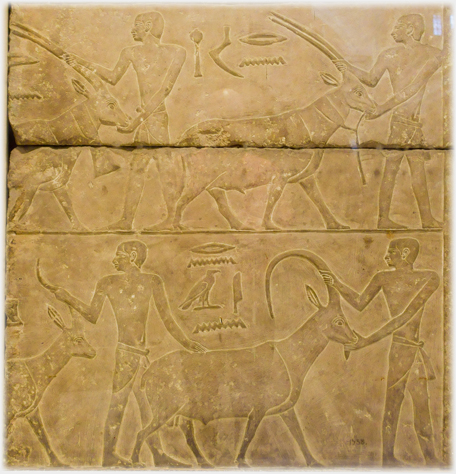 Men tending oryx, antelope and ibex - over 4,500 years ago
These low relief carvings are from a mastaba. Mastabas were ancient Egyptian flat-topped tombs, rectangular or square in plan and with sides sloping outward to the base. The reliefs are carved into limestone. The one shown here is from the area of the Giza pyramid and is dated to the Fourth or Fifth Dynasties; it shows animals which can still be easily identified. Examples of these stones can be seen in both the Metropolitan and British Museums.
Men tending oryx, antelope and ibex - over 4,500 years ago
These low relief carvings are from a mastaba. Mastabas were ancient Egyptian flat-topped tombs, rectangular or square in plan and with sides sloping outward to the base. The reliefs are carved into limestone. The one shown here is from the area of the Giza pyramid and is dated to the Fourth or Fifth Dynasties; it shows animals which can still be easily identified. Examples of these stones can be seen in both the Metropolitan and British Museums.
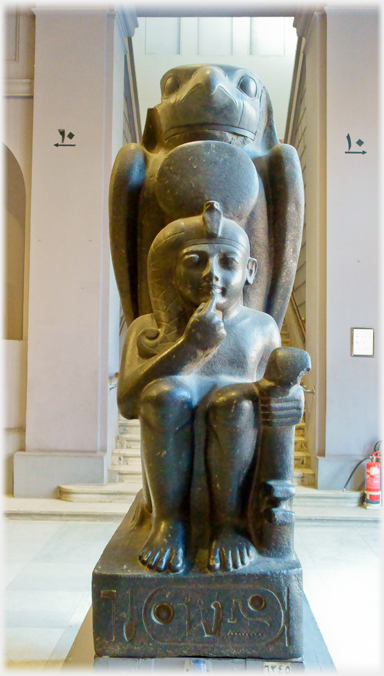 A statue of Ramses II as a boy, guarded by a falcon
A statue of Ramses II as a boy, guarded by a falcon
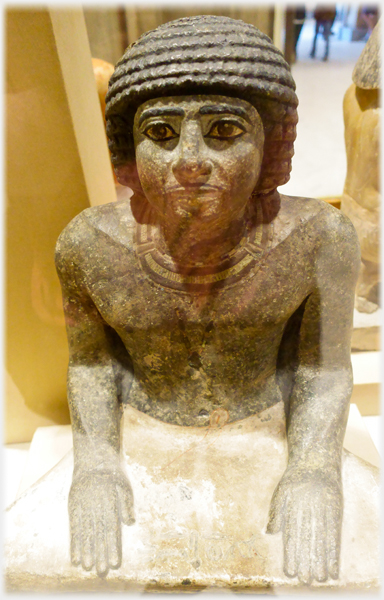 This scribe from the Old Kingdom (Sixth Dynasty), carved in grey granite, is given a name - Ni-maat-sed
This scribe from the Old Kingdom (Sixth Dynasty), carved in grey granite, is given a name - Ni-maat-sed
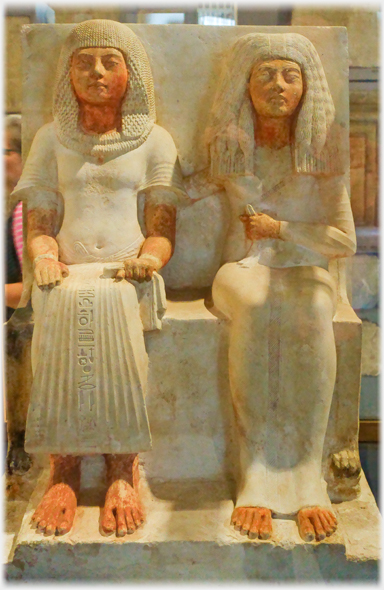 Here another Scribe Meryre Iniuy (Eighteenth Dynasty), with his wife's arm around him...
Here another Scribe Meryre Iniuy (Eighteenth Dynasty), with his wife's arm around him...
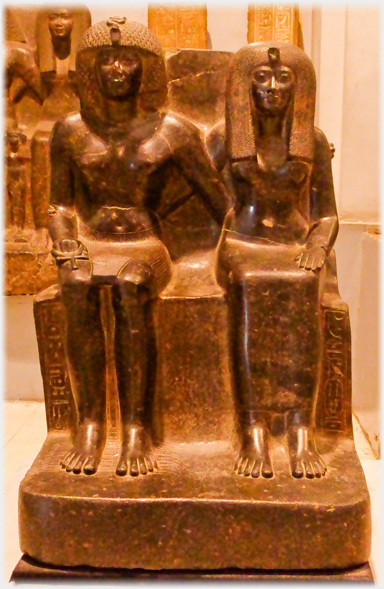 ...an intimacy shown again in the statue of Tuthmosis IV and his mother (Eighteenth Dynasty)...
...an intimacy shown again in the statue of Tuthmosis IV and his mother (Eighteenth Dynasty)...
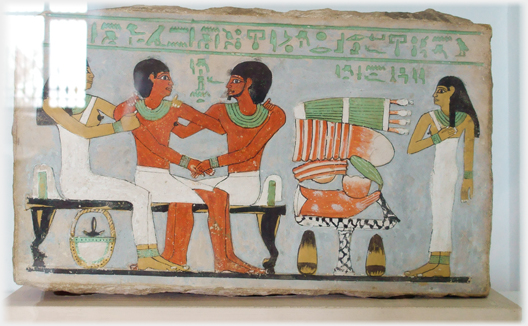 ...but we can go back 500 years to the Twelfth Dynasty and find King Amenemhat sitting with his son and wife, attended by their daughter, again with their arms in a similar position [Sorry I lost the wife's face]
...but we can go back 500 years to the Twelfth Dynasty and find King Amenemhat sitting with his son and wife, attended by their daughter, again with their arms in a similar position [Sorry I lost the wife's face]
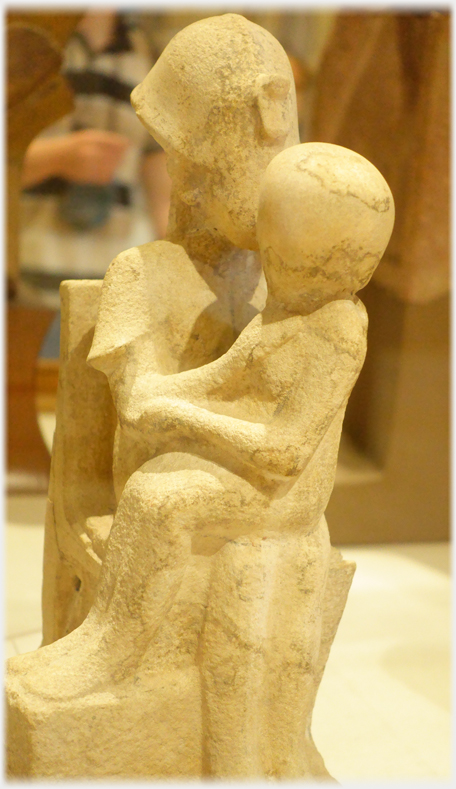 For an even more human and intimate representation this unfinished statuette of King Akhenaten (Eighteenth Dynasty), with his daughter on his knee, must be one of the most personal works to survive from its time of over 3,000 year ago. As a pharaoh he is remembered for attempting to introduce a monotheism to replace the Egyptian pantheism
The next page
goes to the Champa Museum in Đà Nằng with its collection that shows the remarkable meeting of Hindi and Chinese cultures a thousand years ago.
For an even more human and intimate representation this unfinished statuette of King Akhenaten (Eighteenth Dynasty), with his daughter on his knee, must be one of the most personal works to survive from its time of over 3,000 year ago. As a pharaoh he is remembered for attempting to introduce a monotheism to replace the Egyptian pantheism
The next page
goes to the Champa Museum in Đà Nằng with its collection that shows the remarkable meeting of Hindi and Chinese cultures a thousand years ago.
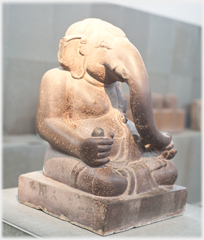

 The last page was about Tahrir Square and the Nile in central Cairo
The last page was about Tahrir Square and the Nile in central Cairo
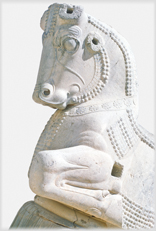
 More modest graves in the Tĩnh Gia district of Vietnam
More modest graves in the Tĩnh Gia district of Vietnam
